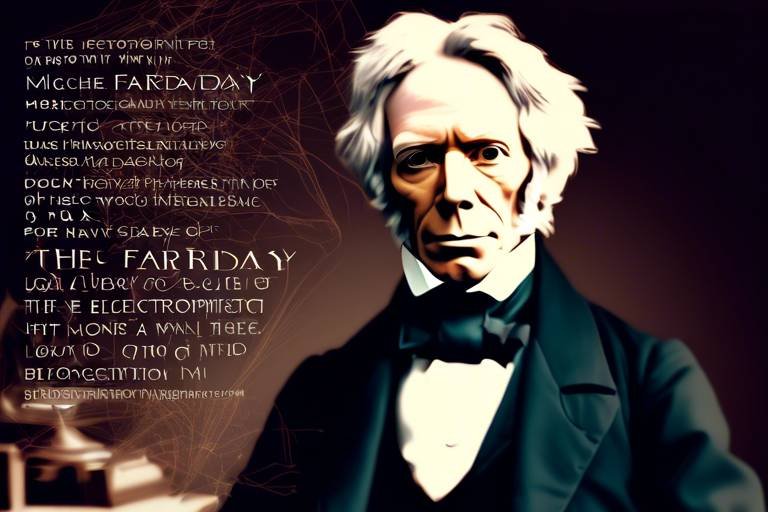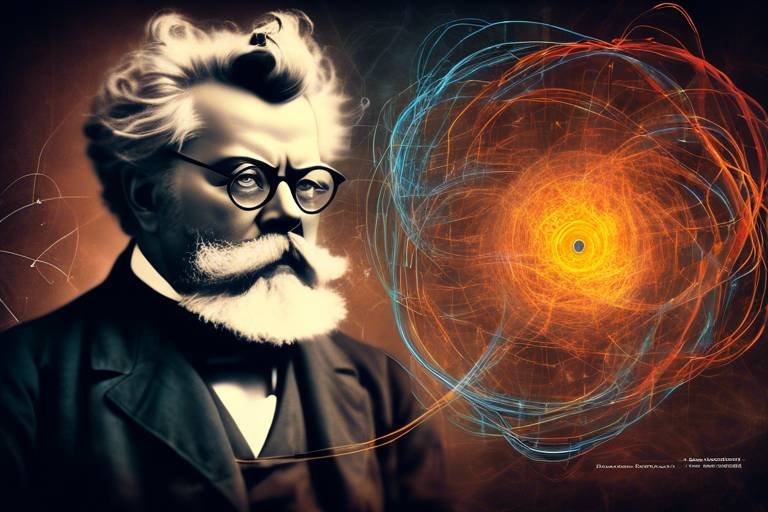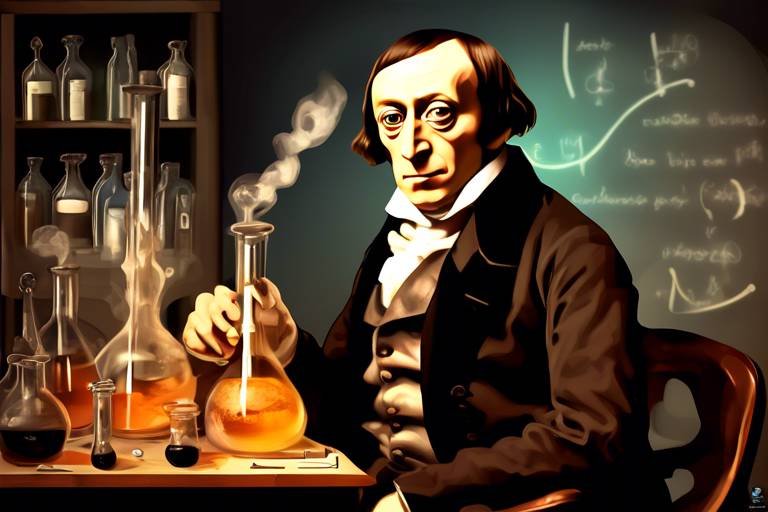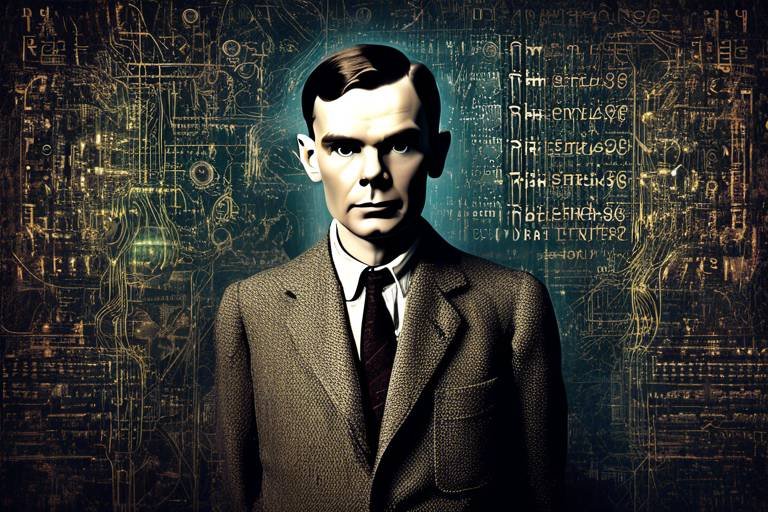The Life of Paul Dirac and Quantum Mechanics
When we think about the giants of physics, names like Einstein and Newton often come to mind. However, one name that deserves equal recognition is Paul Dirac. His life and work not only shaped the field of quantum mechanics but also transformed our understanding of the universe. Born on August 8, 1902, in Bristol, England, Dirac was a prodigy whose academic journey was marked by brilliance and curiosity. He was not just a physicist; he was a visionary who saw the world through a mathematical lens, believing that the beauty of equations could unlock the secrets of nature.
Dirac's contributions to quantum mechanics are nothing short of revolutionary. He was instrumental in formulating the Dirac equation, a groundbreaking equation that describes the behavior of fermions, which are particles like electrons that make up matter. This equation was pivotal because it integrated the principles of quantum mechanics with special relativity, bridging two seemingly disparate realms of physics. Imagine trying to connect two islands separated by a vast ocean; Dirac built that bridge, making it possible for future physicists to traverse the complex landscape of particle physics.
What sets Dirac apart was not just his intellect but also his deep philosophical insights. He believed that scientific theories should be both simple and beautiful, a notion that resonated throughout his work. He often remarked that the most profound discoveries come from simplicity, a principle that guided him in his quest for understanding the fundamental laws of nature. This perspective is akin to an artist who sees beauty in minimalism, where every stroke of the brush adds meaning to the canvas.
In the world of physics, Dirac's legacy is immense. His prediction of antimatter—the idea that for every particle, there exists a corresponding antiparticle—was a game changer. It was like discovering a hidden dimension in a familiar landscape. The eventual identification of the positron, the antiparticle of the electron, validated Dirac's theories and opened new avenues of research. This discovery not only reshaped our understanding of particle physics but also laid the groundwork for technologies such as PET scans in medicine.
As we delve deeper into Dirac's life, we see a man who was not only a scientist but also a mentor and an inspiration to future generations of physicists. His work has influenced countless researchers, guiding them as they navigate the complex waters of quantum mechanics and beyond. Dirac's theories remain foundational, and his influence can be traced through the development of subsequent theories, including quantum field theory. He is a reminder that the pursuit of knowledge is a collaborative journey, one that builds upon the achievements of those who came before.
In conclusion, Paul Dirac's life and work exemplify the intersection of mathematics, philosophy, and physics. His contributions have left an indelible mark on the field of theoretical physics, making him a pivotal figure in our understanding of the quantum world. As we continue to explore the mysteries of the universe, we carry forward Dirac's legacy, a legacy that inspires curiosity, creativity, and a relentless pursuit of truth.
- What is the Dirac equation?
The Dirac equation is a fundamental equation in quantum mechanics that describes the behavior of fermions, integrating quantum mechanics with special relativity. - What is antimatter?
Antimatter refers to particles that have the opposite charge of their corresponding matter particles, such as the positron, which is the antiparticle of the electron. - Why is Dirac's work important?
Dirac's work laid the foundation for modern particle physics, influencing the development of quantum field theory and our understanding of the fundamental forces of nature.

Early Life and Education
Born on August 8, 1902, in the city of Bristol, England, Paul Dirac was destined for greatness from an early age. His father, a Swiss immigrant who worked as a teacher, and his mother, who hailed from a family of English teachers, instilled in him a profound respect for education and knowledge. Growing up in a household that valued learning, Dirac quickly developed a keen interest in mathematics and physics, subjects that would later define his illustrious career.
Dirac's academic journey began at the University of Bristol, where he initially pursued a degree in electrical engineering. However, it was his fascination with physics that eventually led him to switch his focus. This decision proved pivotal, as it set the stage for his groundbreaking work in quantum mechanics. During his studies, Dirac was known for his intense concentration and a somewhat solitary nature, traits that would become synonymous with his character. He often preferred the company of equations over people, diving deep into the complexities of theoretical physics.
After completing his undergraduate degree, Dirac continued his education at the University of Cambridge, where he worked under the guidance of the renowned physicist Ernest Rutherford. It was here that Dirac's genius began to shine. He earned his PhD in 1926, and his groundbreaking dissertation laid the foundation for what would become the Dirac Equation. This equation not only described the behavior of electrons but also elegantly merged quantum mechanics with special relativity, showcasing Dirac's ability to see connections where others saw barriers.
Dirac's academic achievements did not go unnoticed. His unique approach to physics, characterized by a blend of mathematical rigor and philosophical inquiry, began to attract attention. His work was not just about solving equations; it was about understanding the very fabric of reality. This approach would later influence his views on the simplicity and beauty of scientific theories, which he believed were essential for uncovering the truths of the universe.
In summary, Paul Dirac's early life and education were marked by a combination of strong familial support, a passion for learning, and an innate curiosity about the universe. These elements coalesced to create a physicist who would challenge the boundaries of contemporary science and leave an indelible mark on the field of quantum mechanics.

Key Contributions to Quantum Mechanics
Paul Dirac was not just a physicist; he was a revolutionary thinker who reshaped our understanding of the quantum realm. His contributions to quantum mechanics are nothing short of extraordinary, laying the foundation for much of modern theoretical physics. One of his most significant achievements is the formulation of the Dirac equation, which is pivotal for describing the behavior of fermions, particles that make up matter, such as electrons. This equation elegantly merges the principles of quantum mechanics with the theory of special relativity, a feat that had eluded scientists for years.
The Dirac equation fundamentally altered the landscape of particle physics. Before its introduction, the understanding of particles was largely limited to non-relativistic quantum mechanics. However, Dirac's equation opened the door to a new dimension of understanding, predicting not only the behavior of electrons but also hinting at the existence of antimatter. This was a groundbreaking revelation that sent ripples through the scientific community, challenging existing paradigms and sparking further research into the nature of the universe.
To fully appreciate the implications of Dirac's work, let’s delve deeper into the Dirac equation. It can be expressed in a simplified form as follows:
iħγμ∂μψ - mcψ 0
In this equation:
- i is the imaginary unit,
- ħ is the reduced Planck's constant,
- γμ are the gamma matrices,
- ∂μ represents the partial derivative with respect to spacetime coordinates,
- ψ is the wave function of the particle,
- m is the mass of the particle.
This equation not only describes how fermions behave but also introduces the concept of spin, a fundamental property of particles that plays a crucial role in quantum mechanics. Dirac’s exploration of spin led to the development of quantum statistics, which categorizes particles into two distinct groups: fermions and bosons. Fermions, such as electrons, obey the Pauli exclusion principle, meaning that no two fermions can occupy the same quantum state simultaneously. On the other hand, bosons, like photons, can exist in the same state without restriction. This classification is essential for understanding the interactions of particles in the universe.
The implications of Dirac's predictions extended far beyond theoretical constructs. His work laid the groundwork for the discovery of antimatter, which was experimentally confirmed with the identification of the positron in 1932 by Carl Anderson. This discovery was monumental, as it validated Dirac's theoretical predictions and opened up an entirely new field of study in physics. The existence of antimatter not only reshaped our understanding of particle interactions but also raised profound questions about the nature of the universe itself.
In summary, Paul Dirac's contributions to quantum mechanics are foundational. His introduction of the Dirac equation, exploration of spin, and predictions regarding antimatter have not only advanced theoretical physics but have also inspired generations of physicists to delve deeper into the mysteries of the quantum world. Dirac's legacy is a testament to the power of human intellect and the relentless pursuit of knowledge, reminding us that even the most complex phenomena can be understood through elegant and simple equations.

The Dirac Equation
The Dirac equation is not just a mathematical formulation; it is a revolutionary piece of theoretical physics that fundamentally changed our understanding of the quantum realm. Proposed by Paul Dirac in 1928, this equation elegantly combines the principles of quantum mechanics with special relativity. Imagine trying to describe a dance between particles that not only move but also spin and interact in ways we can't see. The Dirac equation provides the choreography for this intricate dance, particularly for particles known as fermions, which include electrons.
What makes the Dirac equation so special? It introduces the concept of spin, a property that gives particles their angular momentum and is crucial for understanding how they behave under various conditions. The equation is expressed as:
(iγ^μ∂_μ - m)ψ 0
Here, ψ represents the wave function of the particle, while γ^μ are the gamma matrices that encode the spin properties. The introduction of these matrices allows the equation to account for the relativistic effects that become significant at high velocities, making it a cornerstone of modern physics.
One of the most astonishing predictions of the Dirac equation is the existence of antimatter. Dirac's mathematical framework suggested that for every particle, there should be a corresponding antiparticle with the same mass but opposite charge. This was a bold idea that seemed almost fantastical at the time, yet it laid the groundwork for the discovery of the positron, the electron's antiparticle, in 1932. This discovery was akin to finding a missing piece of a cosmic puzzle, confirming Dirac's theories and opening up new avenues in particle physics.
Furthermore, the Dirac equation has implications that extend beyond just particles. It has influenced the development of various fields, including quantum field theory and the Standard Model of particle physics. The equation's ability to predict the behavior of particles under different circumstances has made it an essential tool for physicists. It serves as a bridge connecting the abstract world of mathematics with the tangible phenomena of the universe, showcasing Dirac's genius in unifying complex ideas into a coherent framework.
In summary, the Dirac equation is a monumental achievement in theoretical physics. It not only describes the behavior of fermions but also predicts the existence of antimatter and introduces the concept of spin. Dirac's work has had a lasting impact on the field, inspiring generations of physicists to delve deeper into the mysteries of the quantum world.
- What is the significance of the Dirac equation?
The Dirac equation is crucial because it combines quantum mechanics with special relativity, predicting phenomena like antimatter.
- How did Dirac predict antimatter?
Dirac's mathematical framework showed that for every particle, there should be an antiparticle, leading to the discovery of the positron.
- What role does spin play in the Dirac equation?
Spin is a fundamental property of particles that affects their behavior and interactions, and the Dirac equation incorporates this concept through gamma matrices.

Implications of Antimatter
When Paul Dirac introduced the concept of antimatter, he opened a Pandora's box of possibilities that would forever change our understanding of the universe. Imagine a world where every particle has a twin, an opposite counterpart that behaves in ways that challenge our conventional wisdom. This concept, once relegated to the realms of science fiction, became a reality thanks to Dirac's groundbreaking work. The implications of antimatter are profound and far-reaching, impacting not just theoretical physics but also practical applications in various fields.
One of the most significant implications of antimatter is its role in the field of particle physics. The discovery of the positron, the antimatter counterpart of the electron, was a monumental moment in history. It validated Dirac's predictions and showcased the intricate dance of particles and antiparticles in our universe. This discovery has paved the way for further exploration into the fundamental building blocks of matter and the forces that govern them.
Furthermore, the existence of antimatter has implications for our understanding of the universe's origin and composition. The Big Bang theory suggests that equal amounts of matter and antimatter should have been created. However, the observable universe is overwhelmingly composed of matter. This discrepancy raises tantalizing questions about why we see more matter than antimatter, leading to theories about symmetry breaking and the potential for new physics beyond the Standard Model.
In practical terms, antimatter is not just a theoretical curiosity; it has real-world applications as well. For instance, in medical imaging, positron emission tomography (PET) scans utilize positrons to create detailed images of metabolic processes in the body. This technology has revolutionized diagnostic medicine, allowing for earlier detection of diseases like cancer.
Moreover, the potential for harnessing antimatter as a source of energy is another exciting frontier. While we are currently far from achieving this, the energy released in matter-antimatter annihilation is immense. To put it in perspective, just a gram of antimatter could theoretically produce energy equivalent to that of a nuclear bomb. This prospect, while still in the realm of theoretical research, fuels the imagination of scientists and engineers alike.
In summary, the implications of antimatter extend far beyond the confines of theoretical physics. They touch on the very fabric of our universe, challenge our understanding of fundamental principles, and inspire innovations that could change the world. Dirac's legacy, through his prediction of antimatter, continues to resonate and provoke thought, reminding us that the universe is full of mysteries waiting to be unraveled.
- What is antimatter? Antimatter is a type of matter that is composed of antiparticles, which have the same mass as particles of ordinary matter but opposite charges and quantum spin.
- How was antimatter discovered? Antimatter was first predicted by Paul Dirac in 1928, and the positron, the first antimatter particle, was discovered in 1932 by Carl Anderson.
- What are the applications of antimatter? Antimatter has applications in medical imaging techniques like PET scans and has potential implications for energy production.
- Why is there more matter than antimatter in the universe? The imbalance between matter and antimatter in the universe is an area of active research and is thought to involve complex processes that occurred shortly after the Big Bang.

Spin and Quantum Statistics
When we delve into the realm of quantum mechanics, one of the most intriguing concepts is that of spin. Now, you might be wondering, what exactly is spin? Imagine a tiny top spinning on a table. Just like that top, particles such as electrons have a property called spin, which is not just a simple rotation but a fundamental characteristic that defines their behavior in quantum mechanics. Dirac's exploration of spin was revolutionary; he introduced a mathematical framework that allowed scientists to understand how particles behave under various conditions.
In quantum mechanics, particles can be classified into two main categories based on their spin: fermions and bosons. Fermions, which include electrons, protons, and neutrons, have half-integer spins (like 1/2, 3/2), while bosons, such as photons and gluons, possess integer spins (like 0, 1, or 2). This distinction is crucial because it dictates how particles interact with one another. For instance, fermions obey the Pauli Exclusion Principle, which states that no two fermions can occupy the same quantum state simultaneously. This principle is what gives matter its structure; without it, atoms would collapse into a singularity!
On the other hand, bosons can occupy the same state, allowing them to cluster together. This leads to fascinating phenomena such as Bose-Einstein condensates, where particles behave as a single quantum entity at extremely low temperatures. The implications of these classifications extend far beyond theoretical physics; they are foundational in fields such as quantum computing and particle physics.
To better understand the relationship between spin and quantum statistics, let’s take a look at the following table:
| Property | Fermions | Bosons |
|---|---|---|
| Spin | Half-integer (e.g., 1/2) | Integer (e.g., 0, 1) |
| Statistics | Fermi-Dirac statistics | Boltzmann or Bose-Einstein statistics |
| Exclusion Principle | Obeys Pauli Exclusion Principle | Does not obey exclusion principle |
| Examples | Electrons, Protons, Neutrons | Photons, Gluons |
Dirac's insight into spin and its statistical implications opened the door to a deeper understanding of the universe. He did not just stop at defining these particles; he also explored how they interact with each other, leading to the development of quantum field theory. This theory describes how fields and particles are interrelated, fundamentally altering our view of physics. In essence, Dirac's contributions helped bridge the gap between quantum mechanics and the broader universe, allowing us to see the intricate dance of particles that make up everything around us.
In summary, spin is more than just a quirky property of particles; it is a cornerstone of quantum mechanics that influences the very fabric of reality. The classification of particles into fermions and bosons based on their spin leads to a plethora of phenomena that shape our understanding of the universe. Dirac’s work continues to resonate today, reminding us that the universe is not just a collection of objects, but a dynamic interplay of forces and particles governed by the elegant laws of quantum mechanics.
- What is spin in quantum mechanics? Spin is a fundamental property of particles that describes their intrinsic angular momentum, which affects their behavior and interactions.
- What are fermions and bosons? Fermions are particles with half-integer spins that obey the Pauli Exclusion Principle, while bosons have integer spins and can occupy the same quantum state.
- Why is Dirac's work important? Dirac's contributions laid the groundwork for modern quantum mechanics and particle physics, influencing our understanding of the universe and the development of technologies like quantum computing.

Dirac's Philosophical Views
Paul Dirac was not just a brilliant physicist; he was also a profound thinker whose philosophical views shaped his approach to science. He believed that the **beauty** and **simplicity** of equations were not merely aesthetic qualities, but rather fundamental principles that guided the understanding of the universe. In Dirac's eyes, a good scientific theory should be elegant and concise, much like a well-composed piece of music. He often expressed that if a theory was overly complicated, it likely meant that it was not capturing the true essence of the phenomena it aimed to describe.
One of Dirac's most notable philosophical assertions was that "the laws of nature should be expressed in the simplest possible form." This perspective led him to develop theories that were not only groundbreaking but also elegantly simple. For instance, the Dirac equation, which describes the behavior of fermions, is a perfect example of this principle in action. It combines quantum mechanics with special relativity in a remarkably straightforward manner, showcasing how profound insights can emerge from simplicity.
Dirac's belief in the intrinsic beauty of mathematics and physics often set him apart from his contemporaries. While many scientists focused solely on empirical data and experimental verification, Dirac maintained that **mathematical beauty** could lead to deeper truths about the physical world. He once remarked, "It is more important to have beauty in one's equations than to have them fit experiment." This statement encapsulates his view that the elegance of a theory could sometimes be more telling than its immediate applicability.
Moreover, Dirac was known for his **introspective nature**. He often pondered the philosophical implications of his work, asking questions about the nature of reality and the limits of human understanding. This contemplative approach allowed him to delve deeper into the mysteries of quantum mechanics, challenging existing paradigms and opening new avenues of thought. His philosophical inquiries extended beyond the realm of physics, touching on the very fabric of existence and the role of consciousness in the universe.
Dirac's unique perspective has left a lasting impact on the field of theoretical physics. His insistence on simplicity and beauty has influenced generations of physicists, encouraging them to seek elegant solutions to complex problems. As we continue to explore the quantum realm, Dirac's philosophical views remind us that science is not just about equations and experiments; it is also about the profound questions that lie at the heart of our understanding of the universe.
- What was Paul Dirac's most significant contribution to physics?
Dirac's most significant contribution is arguably the Dirac equation, which describes the behavior of fermions and predicts the existence of antimatter.
- How did Dirac's philosophical views influence his scientific work?
Dirac's belief in the beauty and simplicity of equations guided him to develop theories that were not only groundbreaking but also elegantly simple.
- What is the importance of antimatter in physics?
Antimatter plays a critical role in understanding the universe, as it challenges our perceptions of matter and energy, and has practical applications in fields like medical imaging.
- Did Dirac receive any awards for his contributions to physics?
Yes, Dirac was awarded the Nobel Prize in Physics in 1933 for his significant contributions to the field of theoretical physics.

Awards and Recognition
Throughout his illustrious career, Paul Dirac garnered numerous accolades that reflected his profound impact on the field of physics. His groundbreaking work did not go unnoticed, and he was celebrated by the scientific community for his contributions to quantum mechanics and theoretical physics. The pinnacle of his achievements came in 1933 when he was awarded the Nobel Prize in Physics, a testament to his innovative spirit and intellectual prowess.
Dirac's recognition extended beyond the Nobel Prize, as he received several prestigious awards and honors throughout his life. These accolades not only highlighted his groundbreaking theories but also underscored his role as a pioneer in the realm of particle physics. Here’s a glimpse of some of the notable awards he received:
| Award | Year | Description |
|---|---|---|
| Nobel Prize in Physics | 1933 | Awarded for the discovery of new productive forms of atomic theory. |
| Royal Society Fellowship | 1930 | Recognized for his significant contributions to science. |
| Copley Medal | 1973 | For outstanding achievements in scientific research. |
| Max Planck Medal | 1964 | Awarded for his exceptional contributions to theoretical physics. |
Dirac's achievements were not solely academic; he was also honored with various honorary degrees from prestigious universities around the world. These recognitions served as a reflection of his stature in the scientific community and his lasting influence on future generations of physicists.
In addition to awards, Dirac's work has inspired numerous awards and lectureships established in his name, ensuring that his legacy continues to inspire budding physicists. Institutions around the globe recognize his contributions through various programs and events, keeping his spirit alive in the scientific discourse.
Ultimately, Paul Dirac's accolades are a testament to his extraordinary intellect and the indelible mark he left on the world of physics. His ability to merge abstract concepts with practical implications not only earned him recognition during his lifetime but also solidified his place in the annals of scientific history.
- What did Paul Dirac win the Nobel Prize for?
Dirac won the Nobel Prize in Physics in 1933 for his contributions to the development of quantum mechanics, particularly for the discovery of new productive forms of atomic theory. - What is the Dirac equation?
The Dirac equation is a fundamental equation in quantum mechanics that describes the behavior of fermions, such as electrons, and integrates quantum mechanics with special relativity. - How did Dirac influence modern physics?
Dirac's theories laid the groundwork for quantum field theory and have inspired countless physicists, shaping the direction of research in quantum mechanics.

Impact on Future Physicists
Paul Dirac's influence on future physicists is nothing short of monumental. His groundbreaking theories laid the foundation for a new era in physics, one that continues to inspire and guide researchers today. When we think about the ripple effect of his work, it’s akin to tossing a stone into a still pond; the waves of innovation spread far and wide, touching various domains of theoretical physics.
One of the most significant impacts of Dirac's work is the way it shaped the understanding of quantum mechanics. His formulation of the Dirac equation not only described the behavior of electrons but also opened the door to the concept of antimatter. This was a game changer for physicists who followed, as it encouraged them to explore the universe beyond conventional matter. The introduction of antimatter led to a plethora of research opportunities, resulting in the discovery of particles that were previously thought to be purely theoretical.
Moreover, Dirac's insights into spin and quantum statistics have provided a framework for classifying particles into fermions and bosons. This classification is crucial in modern particle physics, influencing everything from the Standard Model to ongoing research in high-energy physics. The implications of his work can be seen in countless experiments and theoretical developments, as physicists strive to unravel the mysteries of the universe.
Dirac's philosophical approach to science also left an indelible mark on future generations. He championed the idea that the beauty and simplicity of equations were essential in understanding the natural world. This perspective has inspired many physicists to seek elegance in their theories, leading to a culture of creativity and innovation in the field. It’s as if Dirac handed down a torch, illuminating the path for others to follow, encouraging them to think deeply about the fundamental principles governing reality.
In addition to these theoretical contributions, Dirac’s legacy can be seen in the way he mentored and influenced young scientists. His dedication to teaching and sharing knowledge has fostered a community of physicists who are not only well-versed in the complexities of quantum mechanics but also passionate about exploring new frontiers. Many prominent physicists attribute their inspiration and direction to Dirac’s work, citing his equations and insights as pivotal in their own research journeys.
To summarize, the impact of Paul Dirac on future physicists can be categorized into several key areas:
- Theoretical Foundations: His work on the Dirac equation and antimatter set the stage for modern particle physics.
- Particle Classification: Introduction of spin and quantum statistics has influenced the understanding of particle behavior.
- Philosophical Inspiration: Dirac's emphasis on beauty and simplicity continues to inspire physicists in their quest for understanding.
- Mentorship and Community: His role as a mentor has fostered a culture of inquiry and collaboration in the scientific community.
Dirac's legacy is not confined to the past; it is a living influence that continues to shape the landscape of physics. As new generations of physicists delve into the complexities of quantum mechanics, they carry forward the torch that Dirac ignited, illuminating the path for future discoveries and innovations.
1. What is the Dirac equation?
The Dirac equation is a fundamental equation in quantum mechanics that describes the behavior of fermions, particularly electrons, and incorporates the principles of special relativity.
2. How did Dirac predict antimatter?
Dirac predicted antimatter through his equation, which suggested that for every particle, there exists a corresponding antiparticle with opposite charge.
3. What is the significance of spin in quantum mechanics?
Spin is a fundamental property of particles that influences their statistical behavior and classification into fermions and bosons, playing a crucial role in quantum field theory.
4. Why is Dirac considered a philosophical physicist?
Dirac emphasized the importance of simplicity and beauty in scientific theories, advocating for equations that elegantly describe natural phenomena, which has influenced many physicists' approaches to research.

Dirac's Legacy in Physics
Paul Dirac's legacy in physics is nothing short of monumental. His groundbreaking work laid the very foundation of modern quantum mechanics, influencing not just theoretical physics but also practical applications in various fields. To put it simply, it's like planting a seed that grows into a magnificent tree, providing shade and fruit for generations to come. Dirac's theories are still relevant today, guiding physicists as they navigate the complex world of subatomic particles.
One of the most significant aspects of Dirac's legacy is his Dirac Equation, which elegantly merges quantum mechanics with special relativity. This equation is pivotal for understanding the behavior of particles at high energies and has become a cornerstone of particle physics. It’s as if Dirac handed the scientific community a key that unlocked a treasure trove of knowledge about the universe. The implications of his work extend far beyond theoretical discussions; they have paved the way for advancements in technology, such as semiconductors and quantum computing.
Moreover, Dirac's prediction of antimatter revolutionized the field of physics. The discovery of the positron, the antiparticle of the electron, was not just a triumph for Dirac but a significant milestone for science as a whole. This finding opened new avenues for research, leading to further explorations in cosmology and high-energy physics. It’s like discovering a new color in a painting; it adds depth and complexity that changes the entire picture.
Dirac's influence is also evident in the realm of quantum statistics. His classification of particles into fermions and bosons has become fundamental in understanding the behavior of matter and forces at the quantum level. This classification helps physicists predict how particles will interact, which is crucial for both theoretical models and experimental setups. The simplicity of his classifications belies their profound implications, showcasing Dirac's belief in the beauty of elegant solutions in science.
Furthermore, Dirac's philosophical views added another layer to his legacy. He believed that the most beautiful theories are often the simplest ones. This approach has inspired countless physicists to seek elegance in their work, leading to a culture of creativity and innovation in theoretical physics. The quest for simplicity is akin to a sculptor chiseling away at a block of marble to reveal a masterpiece; it requires patience, insight, and a deep understanding of the material.
In summary, Paul Dirac's legacy is a rich tapestry woven from his contributions to quantum mechanics, particle physics, and the philosophical underpinnings of scientific inquiry. His work continues to resonate in contemporary research, inspiring new generations of physicists to explore the mysteries of the universe. As we delve deeper into the quantum realm, we carry forward Dirac's torch, illuminating the path with the knowledge and insights he so generously shared.
- What is the Dirac Equation? The Dirac Equation is a fundamental equation in quantum mechanics that describes the behavior of fermions, integrating quantum mechanics with special relativity.
- Why is Dirac's prediction of antimatter important? Dirac's prediction led to the discovery of antimatter, reshaping our understanding of particle physics and the universe.
- How did Dirac influence modern physics? Dirac's work laid the groundwork for quantum field theory and has inspired countless physicists in their research and discoveries.
Frequently Asked Questions
- Who was Paul Dirac?
Paul Dirac was a renowned theoretical physicist known for his groundbreaking work in quantum mechanics. Born in 1902, he made significant contributions that shaped our understanding of particle physics, particularly through the formulation of the Dirac equation.
- What is the Dirac equation?
The Dirac equation is a fundamental equation in quantum mechanics that describes the behavior of fermions, such as electrons. It elegantly combines quantum mechanics with special relativity and predicts the existence of antimatter, which was a revolutionary concept in physics.
- Why is antimatter important?
Antimatter is crucial because it challenges our understanding of the universe. Dirac's prediction led to the discovery of the positron, the electron's antiparticle, and opened new avenues in research, influencing fields like cosmology and particle physics.
- What are fermions and bosons?
Fermions and bosons are two categories of particles in quantum mechanics. Fermions, like electrons, follow the Pauli exclusion principle and make up matter, while bosons, such as photons, mediate forces and can occupy the same quantum state.
- Did Paul Dirac receive any awards?
Yes, Paul Dirac received numerous prestigious awards throughout his career, including the Nobel Prize in Physics in 1933. This honor recognized his significant contributions to quantum mechanics and solidified his legacy in the scientific community.
- How did Dirac influence future physicists?
Dirac's innovative theories and equations inspired countless physicists and laid the groundwork for modern research in quantum mechanics. His work has influenced the development of various theories, including quantum field theory, which is essential for understanding particle interactions.
- What were Dirac's philosophical views on science?
Dirac believed in the beauty and simplicity of scientific theories. He emphasized that equations should be elegant and straightforward, which guided his approach to developing theories in physics and contributed to his unique style of scientific inquiry.
- What is Dirac's legacy in modern physics?
Dirac's legacy is profound; his theories and equations remain foundational to contemporary physics. His insights into quantum mechanics and particle behavior continue to resonate, influencing ongoing research and our understanding of the fundamental forces of nature.



















